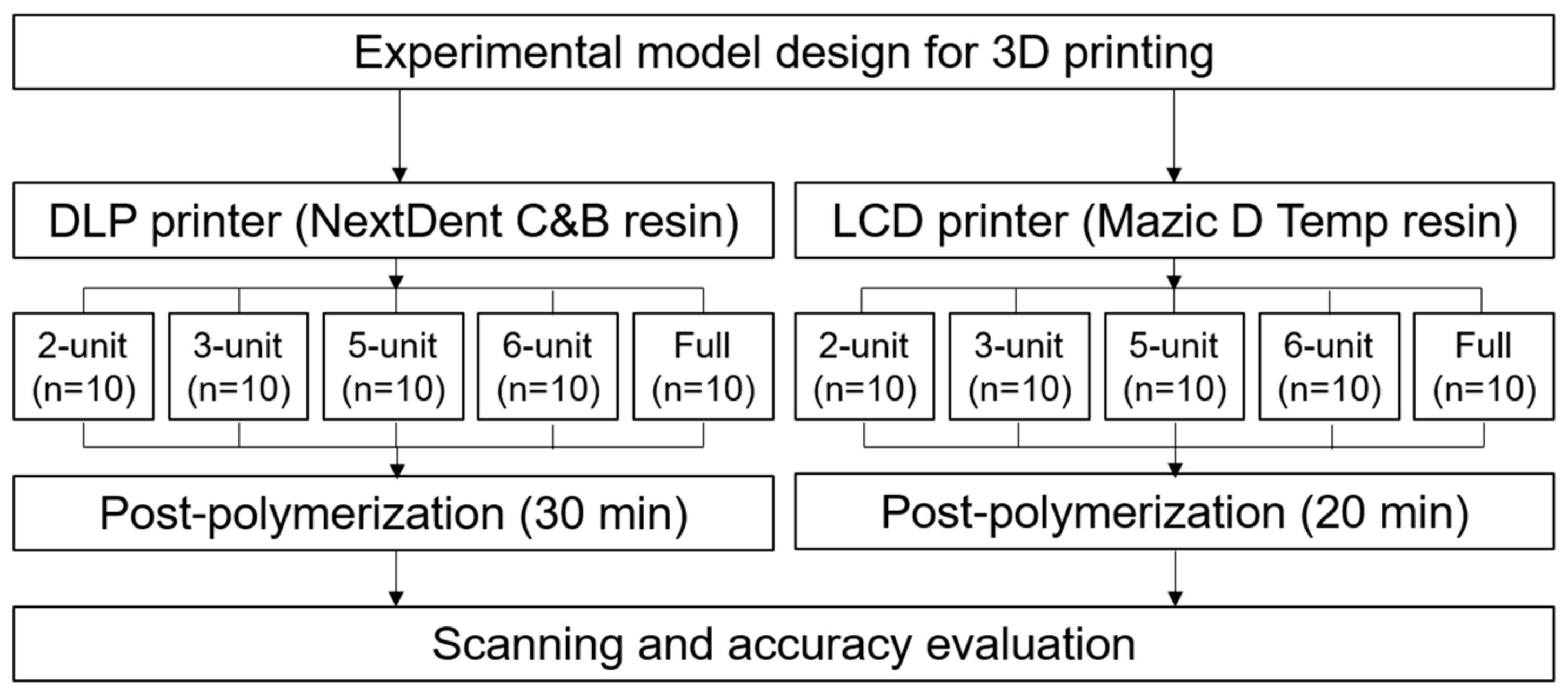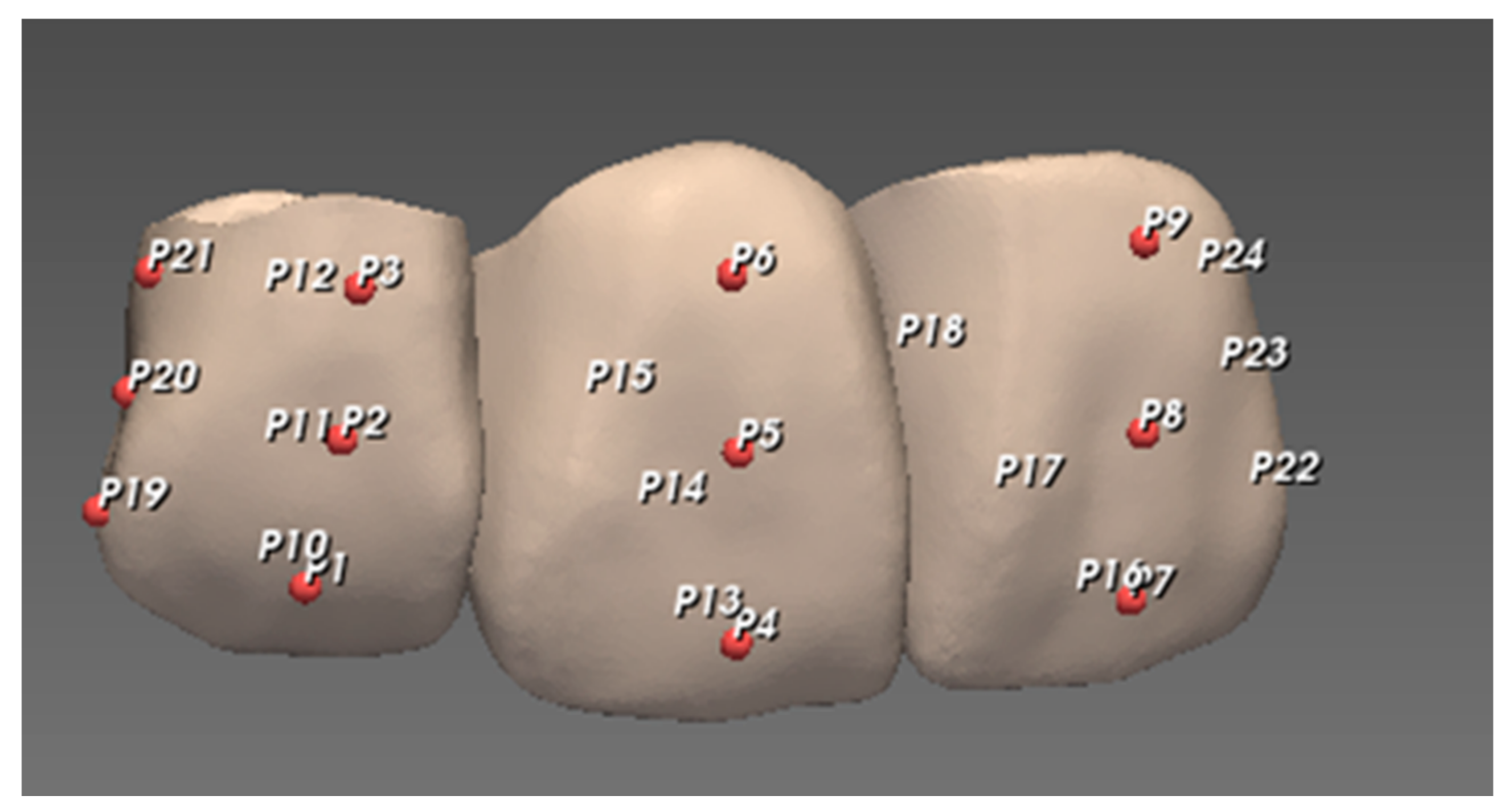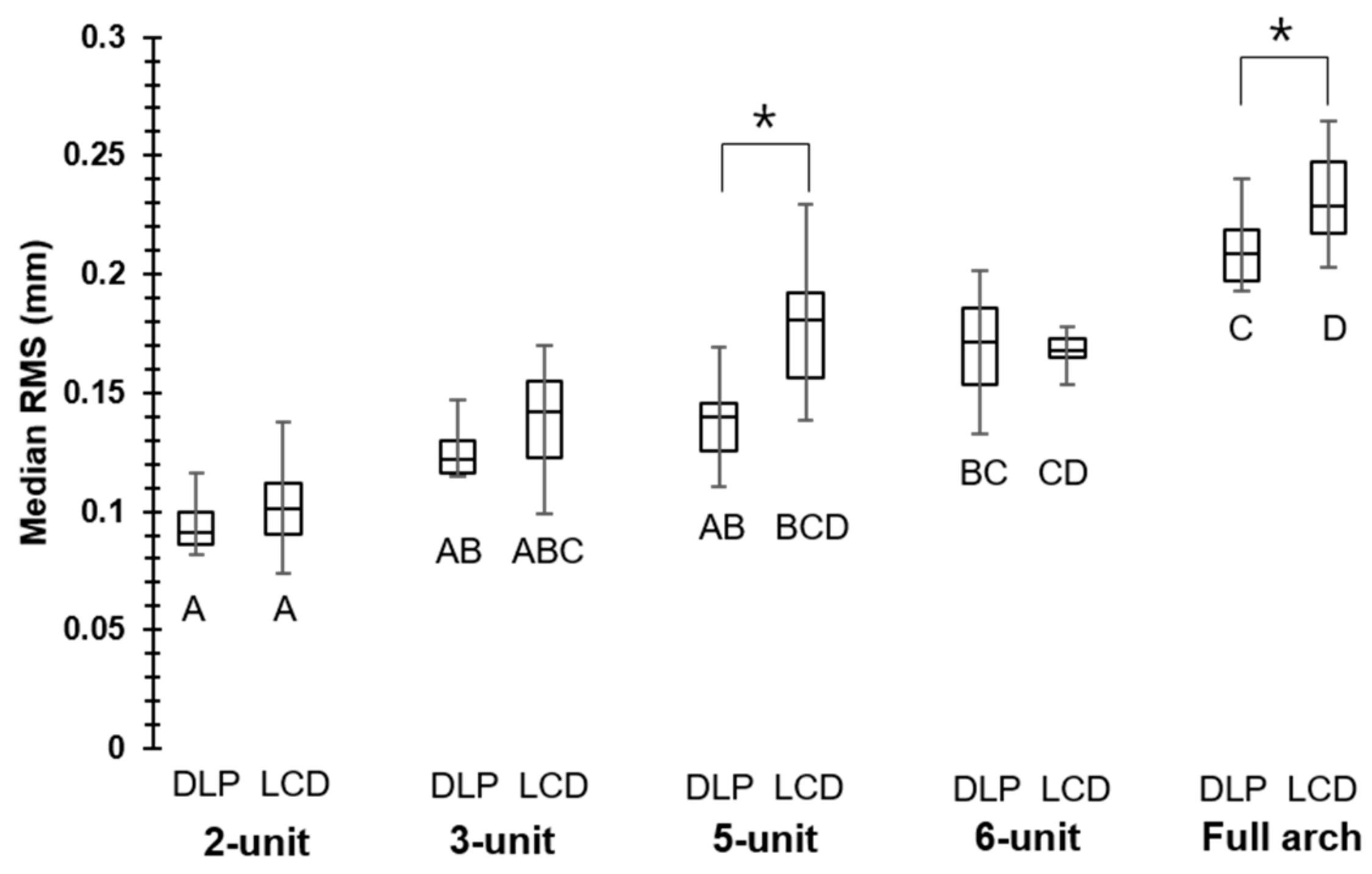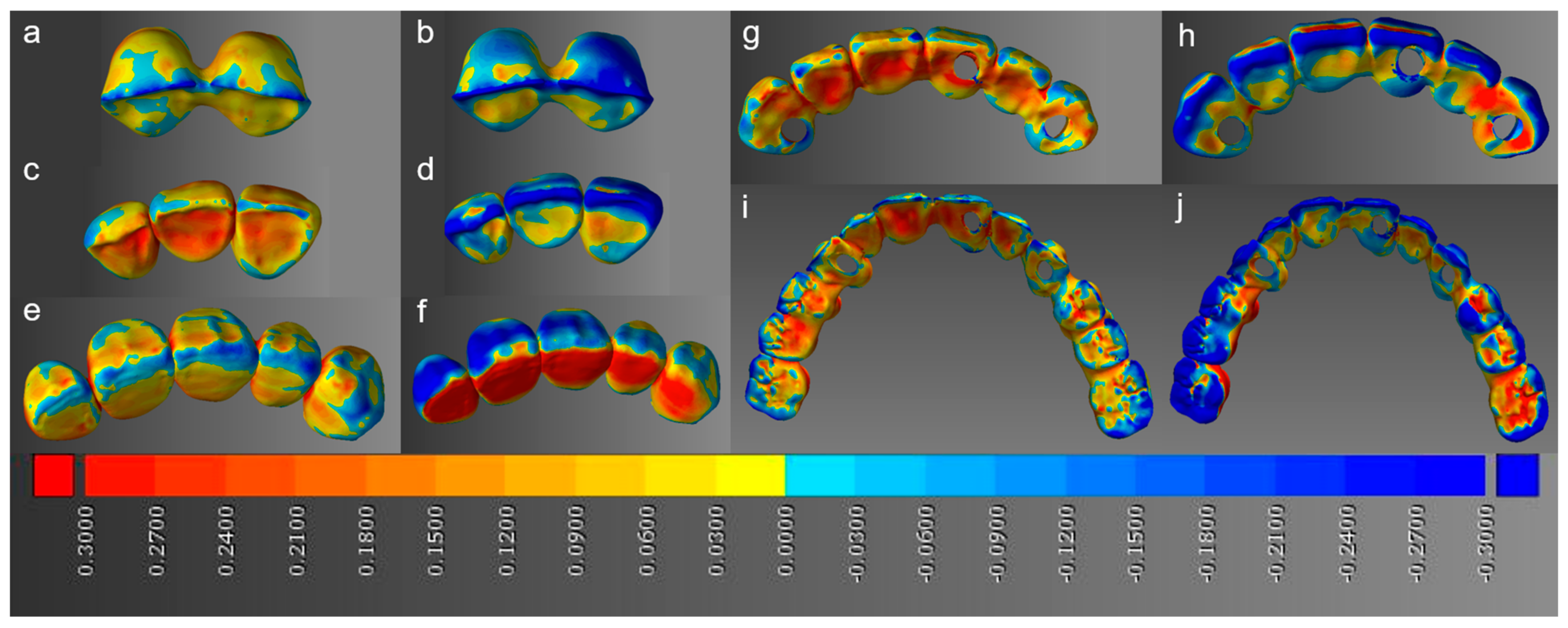Dimensional Accuracy Evaluation of Temporary Dental Restorations with Different 3D Printing Systems
Abstract
1. Introduction
2. Materials and Methods
2.1. 3D Model Fabrication and Scanning
2.2. Superimposition and 3D Deviation Evaluation
2.3. Statistical Analysis
3. Results
3.1. Whole-Deviation Analysis and Color Map
3.2. Point Deviation Analysis
4. Discussion
5. Conclusions
Author Contributions
Funding
Institutional Review Board Statement
Informed Consent Statement
Data Availability Statement
Conflicts of Interest
References
- Tjan, A.H.; Castelnuovo, J.; Shiotsu, G. Marginal fidelity of crowns fabricated from six proprietary provisional materials. J. Prosthet. Dent. 1997, 77, 482–485. [Google Scholar] [CrossRef]
- Karlsen, K. Gingival reactions to dental restorations. Acta Odontol. Scand. 1970, 28, 895–904. [Google Scholar] [CrossRef]
- Dawood, A.; Marti, B.M.; Sauret-Jackson, V.; Darwood, A. 3D printing in dentistry. Br. Dent. J. 2015, 219, 521–529. [Google Scholar] [CrossRef]
- Vasamsetty, P.; Pss, T.; Kukkala, D.; Singamshetty, M.; Gajula, S. 3D printing in dentistry–Exploring the new horizons. Mater. Today 2020, 26, 838–841. [Google Scholar] [CrossRef]
- Rahman, M.M. Statistical Analysis of the Digital Micromirror Devices Hinge Sag Phenomenon. Ph.D. Thesis, Texas Tech University, Lubbock, TX, USA, 2002. [Google Scholar]
- Chen, H.; Cheng, D.-H.; Huang, S.-C.; Lin, Y.-M. Comparison of flexural properties and cytotoxicity of interim materials printed from mono-LCD and DLP 3D printers. J. Prosthet. Dent. 2020, in press. [Google Scholar] [CrossRef]
- Quan, H.; Zhang, T.; Xu, H.; Luo, S.; Nie, J.; Zhu, X. Photo-curing 3D printing technique and its challenges. Bioact. Mater. 2020, 5, 110–115. [Google Scholar] [CrossRef] [PubMed]
- Park, J.-H.; Lee, H.; Kim, J.-W.; Kim, J.-H. Cytocompatibility of 3D printed dental materials for temporary restorations on fibroblasts. BMC Oral Health 2020, 20, 1–9. [Google Scholar] [CrossRef] [PubMed]
- Li, X.; Xie, B.; Jin, J.; Chai, Y.; Chen, Y. 3D printing temporary crown and bridge by temperature controlled mask image projection stereolithography. Procedia Manuf. 2018, 26, 1023–1033. [Google Scholar] [CrossRef]
- Yadav, R.; Kumar, M. Dental restorative composite materials: A review. J. Oral Biosci. 2019, 61, 78–83. [Google Scholar] [CrossRef] [PubMed]
- Dafar, M.O.; Grol, M.W.; Canham, P.B.; Dixon, S.J.; Rizkalla, A.S. Reinforcement of flowable dental composites with titanium dioxide nanotubes. Dent. Mater. 2016, 32, 817–826. [Google Scholar] [CrossRef]
- Noushad, M.; Ab Rahman, I.; Husein, A.; Mohamad, D. Nanohybrid dental composite using silica from biomass waste. Powder Technol. 2016, 299, 19–25. [Google Scholar] [CrossRef]
- Kumar, S.R.; Patnaik, A.; Bhat, I. Development and characterization of marble dust-filled dental composite. J. Compos. Mater. 2017, 51, 1997–2008. [Google Scholar] [CrossRef]
- Altaie, A.; Bubb, N.L.; Franklin, P.; Dowling, A.H.; Fleming, G.J.; Wood, D.J. An approach to understanding tribological behaviour of dental composites through volumetric wear loss and wear mechanism determination; beyond material ranking. J. Dent. 2017, 59, 41–47. [Google Scholar] [CrossRef]
- Ryan, E.-A.; Tam, L.E.; McComb, D. Comparative translucency of esthetic composite resin restorative materials. J. Can. Dent. Assoc. 2010, 76, a84. [Google Scholar]
- Awad, D.; Stawarczyk, B.; Liebermann, A.; Ilie, N. Translucency of esthetic dental restorative CAD/CAM materials and composite resins with respect to thickness and surface roughness. J. Prosthet. Dent. 2015, 113, 534–540. [Google Scholar] [CrossRef]
- Ardu, S.; Braut, V.; Gutemberg, D.; Krejci, I.; Dietschi, D.; Feilzer, A.J. A long-term laboratory test on staining susceptibility of esthetic composite resin materials. Quintessence Int. 2010, 41, 695–702. [Google Scholar] [PubMed]
- Romero, M.F. Esthetic anterior composite resin restorations using a single shade: Step-by-step technique. J. Prosthet. Dent. 2015, 114, 9–12. [Google Scholar] [CrossRef]
- Pagano, S.; Coniglio, M.; Valenti, C.; Negri, P.; Lombardo, G.; Costanzi, E.; Cianetti, S.; Montaseri, A.; Marinucci, L. Biological effects of resin monomers on oral cell populations: Descriptive analysis of literature. Eur. J. Paediatr. Dent. 2019, 20, 224–232. [Google Scholar]
- Shahrubudin, N.; Lee, T.C.; Ramlan, R. An overview on 3D printing technology: Technological, materials, and applications. Procedia Manuf. 2019, 35, 1286–1296. [Google Scholar] [CrossRef]
- Kim, S.-Y.; Shin, Y.-S.; Jung, H.-D.; Hwang, C.-J.; Baik, H.-S.; Cha, J.-Y. Precision and trueness of dental models manufactured with different 3-dimensional printing techniques. Am. J. Orthod. Dentofac. Orthop. 2018, 153, 144–153. [Google Scholar] [CrossRef] [PubMed]
- Fiorenza, L.; Yong, R.; Ranjitkar, S.; Hughes, T.; Quayle, M.; McMenamin, P.G.; Kaidonis, J.; Townsend, G.C.; Adams, J.W. The use of 3D printing in dental anthropology collections. Am. J. Phys. Anthropol. 2018, 167, 400–406. [Google Scholar] [CrossRef]
- Caputi, S.; Varvara, G. Dimensional accuracy of resultant casts made by a monophase, one-step and two-step, and a novel two-step putty/light-body impression technique: An in vitro study. J. Prosthet. Dent. 2008, 99, 274–281. [Google Scholar] [CrossRef]
- Martorelli, M.; Gerbino, S.; Giudice, M.; Ausiello, P. A comparison between customized clear and removable orthodontic appliances manufactured using RP and CNC techniques. Dent. Mater. 2013, 29, e1–e10. [Google Scholar] [CrossRef] [PubMed]
- Hazeveld, A.; Slater, J.J.H.; Ren, Y.; Orthopedics, D. Accuracy and reproducibility of dental replica models reconstructed by different rapid prototyping techniques. Am. J. Orthod. Dentofac. Orthop. 2014, 145, 108–115. [Google Scholar] [CrossRef] [PubMed]
- Brosky, M.; Major, R.; DeLong, R.; Hodges, J.S. Evaluation of dental arch reproduction using three-dimensional optical digitization. J. Prosthet. Dent. 2003, 90, 434–440. [Google Scholar] [CrossRef]
- Nejadebrahim, A.; Ebrahimi, M.; Allonas, X.; Croutxé-Barghorn, C.; Ley, C.; Métral, B. A new safranin based three-component photoinitiating system for high resolution and low shrinkage printed parts via digital light processing. RSC Adv. 2019, 9, 39709–39720. [Google Scholar] [CrossRef]
- Wang, W.; Yu, H.; Liu, Y.; Jiang, X.; Gao, B. Trueness analysis of zirconia crowns fabricated with 3-dimensional printing. J. Prosthet. Dent. 2019, 121, 285–291. [Google Scholar] [CrossRef]
- Labella, R.; Lambrechts, P.; Van Meerbeek, B.; Vanherle, G. Polymerization shrinkage and elasticity of flowable composites and filled adhesives. Dent. Mater. 1999, 15, 128–137. [Google Scholar] [CrossRef]
- Silikas, N.; Eliades, G.; Watts, D. Light intensity effects on resin-composite degree of conversion and shrinkage strain. Dent. Mater. 2000, 16, 292–296. [Google Scholar] [CrossRef]
- Sakaguchi, R.L.; Berge, H.X. Reduced light energy density decreases post-gel contraction while maintaining degree of conversion in composites. J. Dent. 1998, 26, 695–700. [Google Scholar] [CrossRef]
- Ge, J.; Trujillo, M.; Stansbury, J. Synthesis and photopolymerization of low shrinkage methacrylate monomers containing bulky substituent groups. Dent. Mater. 2005, 21, 1163–1169. [Google Scholar] [CrossRef]
- Sherman, S.L.; Kadioglu, O.; Currier, G.F.; Kierl, J.P.; Li, J. Accuracy of digital light processing printing of 3-dimensional dental models. Am. J. Orthod. Dentofac. Orthop. 2020, 157, 422–428. [Google Scholar] [CrossRef]
- Brown, G.B.; Currier, G.F.; Kadioglu, O.; Kierl, J.P. Accuracy of 3-dimensional printed dental models reconstructed from digital intraoral impressions. Am. J. Orthod. Dentofac. Orthop. 2018, 154, 733–739. [Google Scholar] [CrossRef] [PubMed]
- Kim, T.; Lee, S.; Kim, G.B.; Hong, D.; Kwon, J.; Park, J.-W.; Kim, N. Accuracy of a simplified 3D-printed implant surgical guide. J. Prosthet. Dent. 2020, 124, 195–201.e192. [Google Scholar] [CrossRef] [PubMed]
- Rungrojwittayakul, O.; Kan, J.Y.; Shiozaki, K.; Swamidass, R.S.; Goodacre, B.J.; Goodacre, C.J.; Lozada, J.L. Accuracy of 3D printed models created by two technologies of printers with different designs of model base. J. Prosthodont. 2020, 29, 124–128. [Google Scholar] [CrossRef]
- Reymus, M.; Stawarczyk, B. In vitro study on the influence of postpolymerization and aging on the Martens parameters of 3D-printed occlusal devices. J. Prosthet. Dent. 2020, in press. [Google Scholar] [CrossRef]
- Reymus, M.; Fabritius, R.; Keßler, A.; Hickel, R.; Edelhoff, D.; Stawarczyk, B. Fracture load of 3D-printed fixed dental prostheses compared with milled and conventionally fabricated ones: The impact of resin material, build direction, post-curing, and artificial aging—An in vitro study. Clin. Oral Investig. 2020, 24, 701–710. [Google Scholar] [CrossRef] [PubMed]





| NextDent C&B | Mazic D Temp | |
|---|---|---|
| Printer | DLP | LCD |
| Shade | A3.5 | A2 |
| Chemical composition | Methacrylic oligomer, phosphine oxide | Methacrylic oligomer, phosphine oxide |
| Lot. Number | WY364N04 | TP0961A2 |
| Median Point Deviation (mm) | |||
|---|---|---|---|
| DLP | LCD | ||
| 2-unit | Buccal | 0.04 [0.02, 0.07] A | 0.05 [0.03, 0.08] A |
| Lingual | 0.04 [0.02, 0.06] A | 0.07 [0.03, 0.13] A | |
| Proximal | 0.06 [0.03, 0.12] B | 0.06 [0.03, 0.09] A | |
| 3-unit | Buccal | 0.11 [0.04, 0.17] B | 0.05 [0.02, 0.11] A |
| Lingual | 0.04 [0.02, 0.09] A | 0.05 [0.02, 0.12] A | |
| Proximal | 0.07 [0.04, 0.13] B | 0.07 [0.02, 0.12] A | |
| 5-unit | Buccal | 0.06 [0.02, 0.12] B | 0.08 [0.03, 0.23] A |
| Lingual | 0.04 [0.02, 0.07] A | 0.26 [0.09, 0.39] B | |
| Proximal | 0.14 [0.04, 0.21] C | 0.15 [0.11, 0.19] A | |
| 6-unit | Buccal | 0.08 [0.03, 0.16] A | 0.07 [0.02, 0.13] A |
| Lingual | 0.13 [0.05, 0.23] B | 0.06 [0.03, 0.10] A | |
| Proximal | 0.08 [0.03, 0.17] A | 0.14 [0.05, 0.22] B | |
| Full arch | Buccal | 0.09 [0.04, 0.17] A | 0.13 [0.05, 0.23] B |
| Lingual | 0.10 [0.04, 0.19] A | 0.10 [0.04, 0.18] A | |
| Proximal | 0.20 [0.11, 0.28] B | 0.18 [0.12, 0.26] B | |
Publisher’s Note: MDPI stays neutral with regard to jurisdictional claims in published maps and institutional affiliations. |
© 2021 by the authors. Licensee MDPI, Basel, Switzerland. This article is an open access article distributed under the terms and conditions of the Creative Commons Attribution (CC BY) license (http://creativecommons.org/licenses/by/4.0/).
Share and Cite
Moon, W.; Kim, S.; Lim, B.-S.; Park, Y.-S.; Kim, R.J.-Y.; Chung, S.H. Dimensional Accuracy Evaluation of Temporary Dental Restorations with Different 3D Printing Systems. Materials 2021, 14, 1487. https://doi.org/10.3390/ma14061487
Moon W, Kim S, Lim B-S, Park Y-S, Kim RJ-Y, Chung SH. Dimensional Accuracy Evaluation of Temporary Dental Restorations with Different 3D Printing Systems. Materials. 2021; 14(6):1487. https://doi.org/10.3390/ma14061487
Chicago/Turabian StyleMoon, Wonjoon, Seihwan Kim, Bum-Soon Lim, Young-Seok Park, Ryan Jin-Young Kim, and Shin Hye Chung. 2021. "Dimensional Accuracy Evaluation of Temporary Dental Restorations with Different 3D Printing Systems" Materials 14, no. 6: 1487. https://doi.org/10.3390/ma14061487
APA StyleMoon, W., Kim, S., Lim, B.-S., Park, Y.-S., Kim, R. J.-Y., & Chung, S. H. (2021). Dimensional Accuracy Evaluation of Temporary Dental Restorations with Different 3D Printing Systems. Materials, 14(6), 1487. https://doi.org/10.3390/ma14061487






